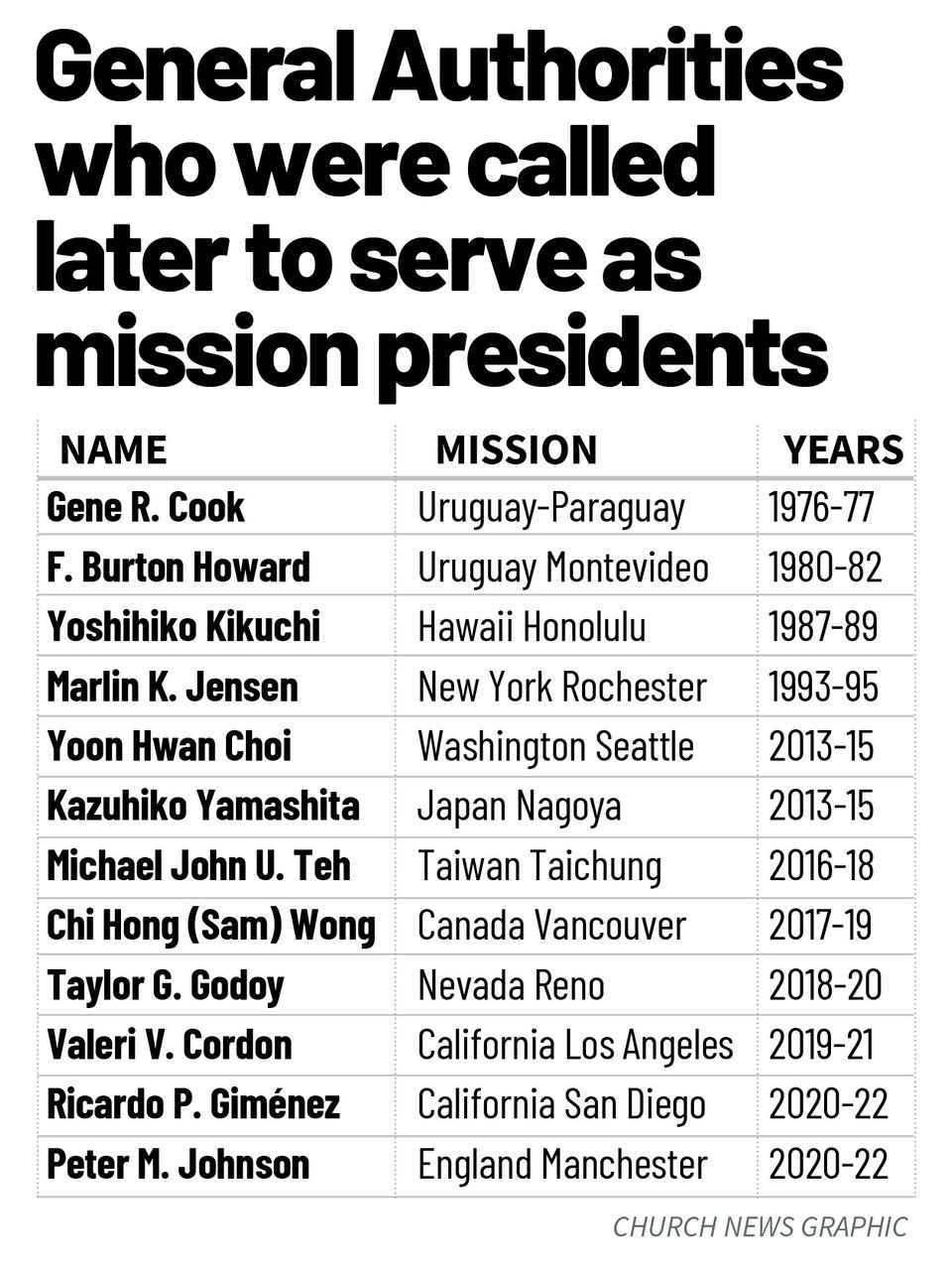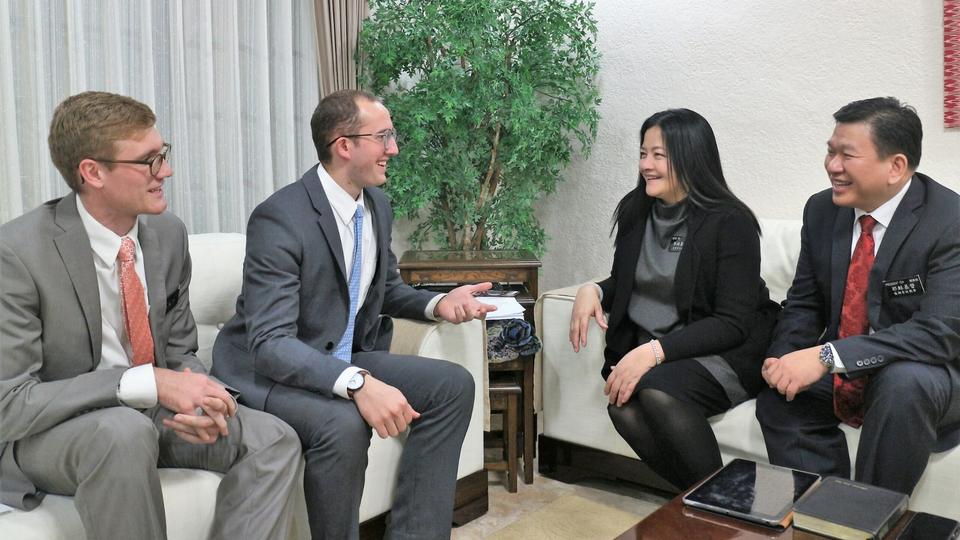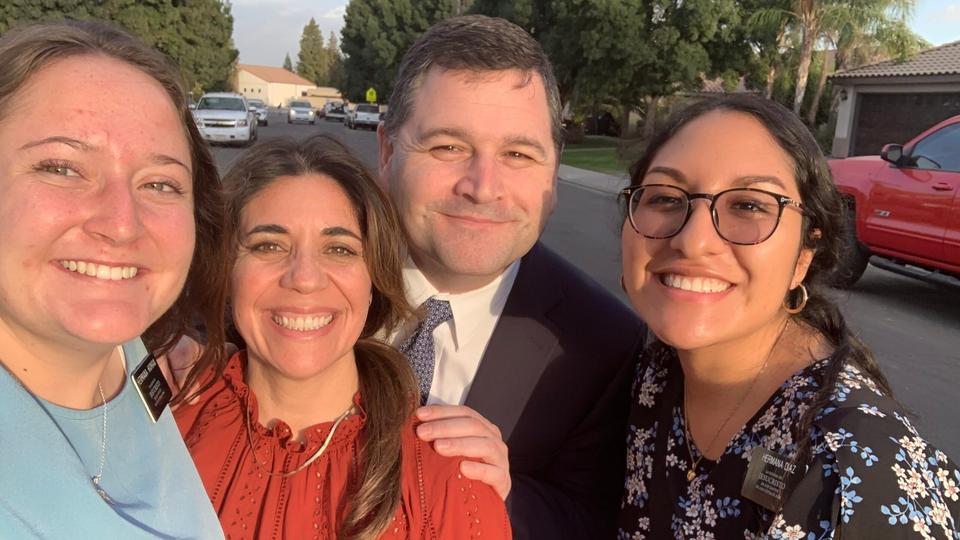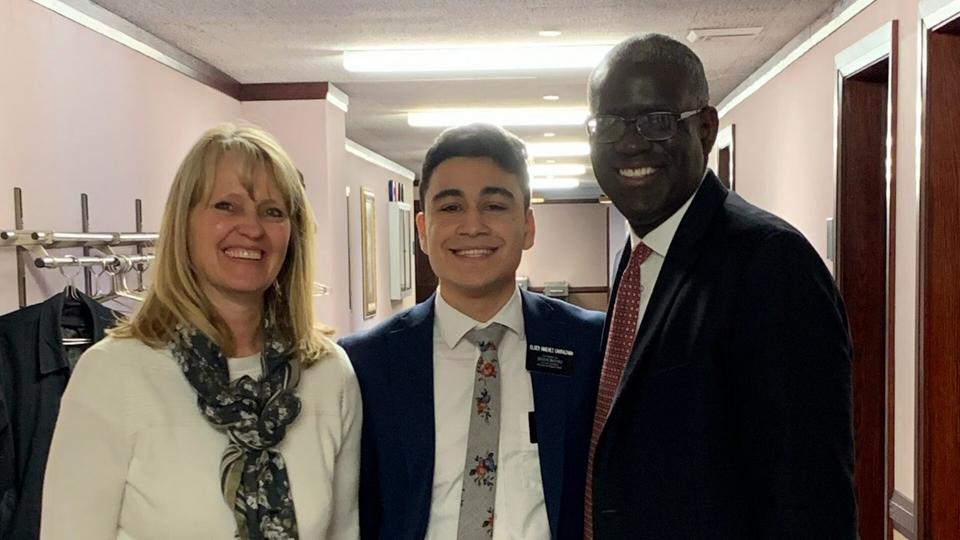- General Authorities later called as mission presidents
- Elder Taylor G. Godoy, Nevada Reno Mission
- Elder Peter M. Johnson, Washington D.C. Mission
- Elder Peter M. Johnson, Washington D.C. South Mission
- Elder Michael John U. Teh, Taiwan
- Elder Peter M. Johnson with son of Elder Ricardo P. Giménez
- Sister Grace Teh, wife of Elder Michael John U. Teh
- Elder Ricardo P. Giménez, California Bakersfield Mission
- Elder Taylor G. Godoy, Nevada Reno Mission zone activity
| Temple Square is always beautiful in the springtime. Gardeners work to prepare the ground for General Conference. © 2012 Intellectual Reserve, Inc. All rights reserved. | 1 / 2 |
This story appears here courtesy of TheChurchNews.com. It is not for use by other media.
By Sydney Walker and Scott Taylor, Church News
Less than a year after Elder Ricardo P. Giménez and Elder Peter M. Johnson were sustained as new General Authority Seventies, they received calls to serve as mission presidents.
Beginning July 2020, Elder Giménez will preside over the California San Diego Mission, and Elder Johnson will preside over the England Manchester Mission.
Elder Giménez and Elder Johnson aren’t the only General Authorities to serve as mission presidents. Others include Elder Taylor G. Godoy, who is currently presiding over the Nevada Reno Mission, and Elder Michael John U. Teh, who returned in 2018 from the Taiwan Taichung Mission.
Why are some General Authorities called as mission presidents? How often does this happen?
There is no principal answer as to “why,” Elder Dieter F. Uchtdorf said, but having General Authorities serve as mission presidents is “very valuable” — both for them and for The Church of Jesus Christ of Latter-day Saints.
As a member of the Quorum of the Twelve Apostles and chairman of the Missionary Executive Council, Elder Uchtdorf met with the Church News and provided insight to this somewhat occurrence of General Authorities serving as mission presidents.
A Blessing for the General Authority and the Church
General Authorities are not required to have experience serving as a mission president, said Elder Uchtdorf, who himself hasn’t presided over a mission. None of the current members of the First Presidency served as mission presidents, and only five of the Twelve have.
“Many of the General Authorities nowadays are younger. They have a long life to serve as a General Authority,” Elder Uchtdorf explained. “So if it fits into their schedule and into their background and their age group and everything, then it’s a great advantage if we send them out.”
Sometimes, current mission presidents are called as General Authority Seventies — two of the most recent examples are Elder Matthew S. Holland (North Carolina Raleigh Mission) and Elder Thierry K. Mutombo (Maryland Baltimore Mission), who were sustained as General Authority Seventies during the April 2020 general conference while presiding over their respective missions.
An earlier example is Elder William R. Bradford, who was only months into presiding as Chile Santiago Mission president when called as a General Authority at the October 1975 general conference — and who continued to serve three years as mission president in Santiago.
In other instances, General Authority Seventies have been temporarily reassigned to preside over missions due to health concerns or other circumstances.

General Authorities later called as mission presidents
General Authorities who were called later to serve as mission presidents. Graphic courtesy of Church News. © 2020 Deseret News Publishing Company.The mission experience dually benefits the General Authority and the Church, Elder Uchtdorf said. “They come back with a wonderful pool of wisdom and experience, which will help us and the Church altogether to become better in how we serve our missionaries, how we better serve our mission presidents, how we better connect members and missionaries, the member leaders — stake presidents, bishops — and the mission leadership out there in the field.”
The varied mission experiences and perspectives among the General Authorities are valuable, especially as circumstances change, Elder Uchtdorf said. For example, “Those who served as mission presidents 40 years ago had different circumstances and different mission requirements than today.”
Elder Teh had served as a General Authority Seventy for about nine years when he was called to preside over the Taiwan Taichung Mission from 2016 to 2018. The Philippines native said he gained a greater love for the Chinese people and a greater understanding of God’s plan for him individually. He also learned to recognize the spiritual strength and capacity of the youth.

Elder Michael John U. Teh, Taiwan
Elder Michael John U. Teh, right, and his wife, Sister Grace Teh, talk with missionaries serving in Taiwan. Elder and Sister Teh presided over the Taiwan Taichung Mission from 2016 to 2018. Photo courtesy of Elder Michael John U. Teh, courtesy of Church News.Elder Teh’s wife, Sister Grace Teh, said of her experience in Taiwan, “For me, the whole purpose of our call was to experience and to learn and to enlarge our hearts and minds to see the grandeur of His work.”
Elder Godoy concludes his service in the Nevada Reno Mission in June and will serve as first counselor in the Central America Area presidency. He described his time in the mission field as “amazing” as well as “intensive and extensive.”“It helped me a lot to catch the vision about the missionary purpose,” Elder Godoy said. “And of course it will help me a lot in future mission tours to minister to the mission president in a different way and to help the missionaries to be focused on those basic things of missionary work, like obedience, finding, teaching, baptizing and fellowshipping.”
Similarities to and Differences from Other Mission Presidents
Despite common myths, General Authorities aren’t assigned to a certain location because of a mission’s problems or obedience issues, nor is a mission seen as having any special esteem or merit to be presided over by a General Authority mission president.
“It’s not something mystic,” Elder Uchtdorf said of a General Authority’s mission assignment. “It’s something very practical.”
General Authorities are called as mission presidents the same way other mission presidents and missionaries are called, Elder Uchtdorf said. “It’s done by inspiration. It’s really done considering for whom we feel this would be just the right thing to do.”
Just like other prospective mission presidents, Elder Giménez and Elder Johnson met with a member of the Quorum of the Twelve Apostles for an exploratory interview to see if they were willing and able to serve. Then, a member of the First Presidency extended the call. They each received a mission call letter outlining where and when they would serve.
Typically, General Authorities serve as mission presidents for two years rather than three. But “there’s no big difference,” Elder Uchtdorf said, between their service and that of a traditional mission president.
General Authorities serving as mission presidents are called “president,” not “elder.”
“I think with everything they do in the mission field, they are more cognizantly digesting what they do into their future role as a General Authority,” Elder Uchtdorf said. “(But) we hope they focus on what they are doing now, not just make notes or look forward as a General Authority.”
Of his service in Taiwan, Elder Teh said: “I only wore my ‘mission president hat,’ and left my ‘General Authority hat’ in Salt Lake City. … I often emphasized that I was there as a mission president and not as a Seventy.”
He said his prior experience as a General Authority Seventy gave him “a bird’s-eye view” of his role and the overall objective of the mission. However, the day-to-day operations were different than he expected.
“We learned quickly that that knowledge can only be had by actually being on the job,” Elder Teh said. “In fact, a couple of weeks before we were to enter the MTC I had a stark realization: Even though I have trained many mission presidents and conducted countless mission tours, I didn’t really know how to be a mission president.”
Elder Godoy’s advice for newly called General Authority mission presidents: “Goals, plans and ideas should be set, considering we have two years instead of three.”

Elder Ricardo P. Giménez, California Bakersfield Mission
Elder Ricardo P. Giménez, middle right, and his wife, Sister Catherine Giménez, are pictured with Sister Human and Sister Diaz during a mission tour to the California Bakersfield Mission on Oct. 17, 2019. Elder Giménez has been called to serve as president of the California San Diego Mission beginning in July 2020. Photo courtesy of Elder Ricardo P. Giménez, courtesy of Church News.Preparing to Serve
For the past year since his call as a General Authority Seventy, Elder Giménez has been assisting the North America West Area presidency. A call to serve in California is “a double blessing,” he said, because he already feels “part of the area” — not only in being acquainted with the area presidency and their directives but also in having participated in area mission leadership seminars with currently serving mission presidents and companions.
“I’ve got a very clear picture of what we need to do,” Elder Giménez said. “And it’s going to be focused on the basics: We preach repentance. We have faith. We are 100% obedient. We find all the time. We invite people to come. We work with local leaders.”
He is also looking forward to serving alongside his wife, Sister Kathy Giménez. “Probably 70 or 80% of the time, I’m by myself. Now, the calling is for us together. She’s my companion, and she will be a missionary as well.”
Sister Giménez said she put her online accounting classes on hold so she could spend more time in the scriptures and “Preach My Gospel” as she prepares to serve. She is looking forward to being “really immersed in the gathering of Israel.”
“I want to be as ready as I can,” Sister Giménez said. “My goal is to be a real instrument in the Lord’s hand so I can do whatever He wants me to do.”
Elder Giménez added, “We are hoping to do our best, to serve the Lord and do a lot of good things to help the stakes and wards there to have real growth.”
Elder and Sister Johnson have also been preparing for their mission by studying the Book of Mormon and “Preach My Gospel.” Going on mission tours prior to the COVID-19 outbreak gave added perspective to their call.
“I’m grateful that we’ve had this advanced training, in a way, to help us prepare for what we think is going to be probably one of the greatest callings that we’ve ever shared together in our lives,” Elder Johnson said.

“Flying in, before I got off the plane, I had this overwhelming love for these missionaries that we were just going to speak to and be part of for a week. I didn’t know any of them,” she said. “But there was that instant love I felt for them. So I can’t even imagine being a mission president’s wife, how you feel that love, that instant connection, for these missionaries.”
Later that trip, while visiting sister missionaries in their apartment, Sister Johnson remembers asking a new Spanish-speaking sister how she was doing.
The sister missionary responded, “Well, I’m not confident in me right now, but I can be confident in the Lord.”
Copyright 2020 Deseret News Publishing Company